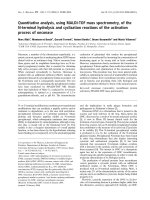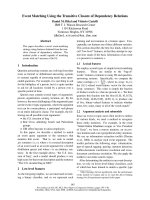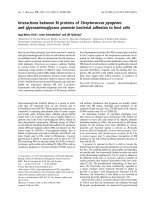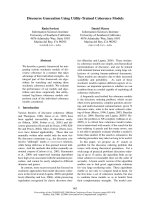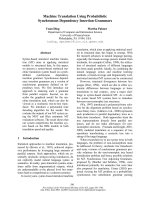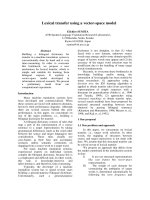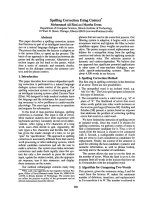Báo cáo khoa học: "Diagram Understanding Using Integration of Layout Information and Textual Information" ppt
Bạn đang xem bản rút gọn của tài liệu. Xem và tải ngay bản đầy đủ của tài liệu tại đây (537.51 KB, 7 trang )
Diagram Understanding Using Integration of
Layout Information and Textual Information
Yasuhiko
Watanabe
Ryukoku University
Seta,
Otsu
Shiga, Japan
Makoto Nagao
Kyoto
University
Yoshida, Sakyo-ku
Kyoto, Japan
1 Introduction
Pattern information and natural language informa-
tion used together can complement and reinforce
each other to enable more effective communication
than can either medium alone (Feiner 91) (Naka-
mura 93). One of the good examples is a pictorial
book of flora (PBF). In the PBF, readable explana-
tions which combine texts, pictures, and diagrams
are achieved, as shown in Figure 1 and 2. Taking
advantage of this, we propose here a new method
for analyzing the PBF diagrams by using natural
language information.
In the PBF, many kinds of information about
plants are generally stored in the following media:
• picture,
• explanation text, and
• diagram.
Pictures and explanation texts describe the shape,
botany, and environment of each plant, as shown in
Figure 1. On the contrary, as shown in Figure 2,
diagrams describe very clearly the following kinds
of information:
• correspondence between each part of the plant
and its name
• part-whole relationship and synonymous words
As a result, diagrams are quite important in or-
der to understand the explanation of each plant.
For example, pictures and explanation texts cannot
convey the information which is necessary to answer
the
following questions:
• which part of plant is
"takuyou
(stipules)"?
• what shape is
"hishinkei
(lanceolate shape)"?
Consequently, we have to investigate the method
for understanding diagrams.
It is certain that diagrams are effective means
of communication. However, it is also true that
we feel difficulties when we try to understand dia-
grams without the explanation by natural language.
From this, we conclude that natural language infor-
mation is important to understand diagrams. Corn
sequently, we propose a new framework for the in-
spiraea
cantoniensis
~: ~, ~ 1.5m ~'~-
2-5cm, W 6-20mm~ ~a~j,
Figure 1: An example ofa PBF article (in Japanese)
chumyaku
(midrib)
youeki
(axii) !
mitsusen youhei
(petiole) !
(nectary) ~
takuyou
(stipules)
ha (leaf)
Figure 2: An examples of PBF diagrams (leaf)
tegration of pattern (layout) information and natu-
ral language information for semantic understand-
ing the PBF diagrams. In this study, for the obser-
vation and experiments, we use a PBF (in Japanese)
the subject of which are wild flowers of Japan.
1374
!
/\
daenkei hishinkei shinkei
('ellipsoidal) ('lanceolate) ~cordate\ shape
)
k shape
\
shape
ha no katachi
(leaf shape)
Figure 3: The shape of leaf
2 Diagram Understanding
2.1 PBF Diagram
Understanding
A diagram in the PBF consists of its title and ele-
ments. A title shows the subject of the diagram and
it is generally located under the diagram. Elements
may be classified into three types:
• symbol,
• sketch,
•
word.
Symbols (arrow, line, parenthesis, etc.) connect di-
agram elements. Sketches represent the features of
a plant readably and accurately. The features rep-
resented by sketches are explained by words in the
diagram. Observing the PBF diagrams, the infor-
mation explained by words is classified into five cat-
egories, such as:
1. names of plant parts.
(example)
"takuyou
(stipules)" in Figure 2
2. types of plant parts.
(example)
"taika
(follicle)" and
"mikanjyoka
(hespidium)" in Figure 4
3. properties of plant parts.
(example)
"daenkei
(ellipsoidal shape)" in Fig-
ure 3
4. names of plant species.
(example)
"katsura"
and
"natsumikan"
in Fig-
ure 4
5. additional explanation.
(example)
"shinpi no chuou ga sakeru
(carpel
splits open in its center)" in Figure 5
Diagram understanding is the semantic interpreta-
tion of the elements in the diagram. As mentioned,
in the PBF diagrams, the information represented
by sketches is explained by words. From this, we
?can'
'katsura '
taika
(follicle)
mikanjyoka
(hespidlum)
kajitsu"
(fruit).
Figure 4: The variety of fruits
houhairekkai
(Ioculicidal dehiscence)
shinpi no chuou ga sakeru
(carpel splits open in its center)
rekkai
(dehiscence)
Figure 5: The process of dehiscence
conclude that the semantic interpretation of the
PBF diagrams is the classification of words in a di-
agram into these five categories.
For this purpose, we propose a new framework for
the semantic interpretation of words in the PBF di-
agrams by using not only the pattern (layout) infor-
mation but also the natural language information.
The reason is as follows: there is no composing rule
that strongly restricts the positions of elements and
the semantic relations between elements. In other
words, there are many ways of composing diagrams
to explain an idea. For this reason, it is difficult to
interpret the PBF diagrams only by using the pat-
tern (layout) information. For example,
"daenkei
(ellipsoidal shape)",
"hishinkei
(lanceolate shape)",
and
"shinkei
(cordate shape)" in Figure 3 represent
the properties of the plant part, on the contrary,
"taika
(follicle)" and
"mikanjyoka
(hespidium)" in
Figure 4 represent the types of the plant part. In
spite of the semantic difference, all these words are
located under the corresponding sketches, respec-
tively.
2.2 Related Work
There are a few research topics related to diagram
understanding. (Plant 89) (Futrelle 90) recognized
the semantic structure of diagrams as the extension
of diagram analysis. But they analyzed diagrams
1375
by using knowledge about diagrams which is quite
separate from natural language information. On
the contrary, (Nakamura 93) analyzed diagrams in
the encyclopedia dictionary by using its explanation
texts and the thesaurus information. But it is diffi-
cult to analyze the PBF diagrams in the same way
as (Nakamura 93) did. The reasons are as follows:
• It is certain that the explanation texts in the
PBF are closely related to the PBF diagrams.
However, these texts do not describe the con-
tents of diagrams but the features of plants.
That is, there is no explanation text for the
PBF diagrams.
• Words in the PBF diagrams are generally tech-
nical terms which are not registered in the
common thesaurus.
To solve these problems, we propose a new frame-
work to analyze the PBF diagrams by using many
kinds of clue expressions in the PBF explanation
texts.
3 Information for PBF Diagram
Understanding
3.1 Layout Information
For analyzing the PBF diagrams, we utilize two
kinds of layout information. These are:
• type of relationships between diagram elements
• similarity of spatial relationships between di-
agram elements
Every word in the PBF diagrams is related to the
other elements (sketches or other words). The re-
lationships between words and the corresponding
elements are classified into 2 types:
connection is the relationship between the word
and its corresponding element. These are con-
nected together by a symbol. For example, the
relationship between "takuyou (stipules)" and
the "leaf" sketch in Figure 2 is connection.
adjacency is the relationship between the word
and its corresponding element. These are ad-
jacent to each other and not connected by
a symbol. For example, the relationship be-
tween "natsumikan" and the right sketch in
the Figure 4 is adjacency.
A word connected by a symbol represents a name
of the plant part. Consequently, in this case, the
spatial relationship between the word and the corre-
sponding element is not important for the semantic
interpretation. For example, the semantic interpre-
tation of "mitsusen (nectary)" in Figure 2 would
remain unchanged even if "mi~susen" was located
on the right of the "leaf" sketch.
On the contrary, a word which is not connected
by a symbol may represent any type of informa-
tion. Consequently, in this case, the spatial rela-
tionship between the word and the corresponding
element is important for the semantic interpreta-
tion. For example, it is inadequate to replace the
position between "mikanjyoka" and "natsumikan"
in Figure 4. It is because the replacement breaks the
similarity of the spatial relationship which "mikan-
jyoka (hespidium)" and "taika (follicle)" have. In
this way, words in the PBF diagrams which repre-
sent the same kind of information, often have the
same spatial relationship. From this, we utilize the
similarity of the spatial relationships for the prop-
agation of the semantic interpretation in this way:
suppose that words A and B have the same spatial
relationship. If A is given the semantic interpreta-
tion but B is not, the semantic interpretation of A
is given to B.
3.2 Natural Language Information
As mentioned previously, the PBF texts do not ex-
plain the PBF diagrams but describe many kinds
of plants. The explanation texts, however, include
many clues which are useful to classify the words in
the PBF diagrams into the five semantic categories.
In order to realize the semantic analysis, we uti-
lize two kinds of natural language information for
diagram understanding. These are:
• titles of the PBF articles.
• typical expressions which show implicitly the
semantic interpretation of words in the PBF
diagram.
Titles of the PBF articles represent names of the
species. Typical expressions which we utilize for
analyzing the diagrams are such as:
(a) A + ha + predicative noun
(b) A + ga + aru (exist)
(c) A + ga + verbalized noun + suru
(d) ha + A (A is a predicative noun)
(e) A (A is a verbalized noun) + suru
where A is a word in the diagram, "ha" and "ga" are
Japanese postpositions, and "suru" accompanies a
noun and verbalizes it. These five expression pat-
terns are useful to interpret the words in the PBF
diagrams. For example, words which represent the
names of plant parts are found in expressions (a),
(b), and (c), as shown in text (S-l) (S-3), but
not in expressions (d) and (e).
(S-I) ha (leaf) ha daenkei (ellipsoidal shape)
(S-2) kibu ni (at the base) ha milsusen (nectary)
ga aru (exist)
(S-3) rimen ni (in the back) ha myaku (vein) ni
sotte (along) ke (hair) ga missei (glow tightly)
suru
On the contrary, words which represent the prop-
erties are found in the expressions (d) and (e), as
shown in texts (S-4) and (S-5), but not in expres-
sions (a), (b), and (c).
1376
meshibe
(pistil) /~
oshibe
oshibe
[ ~-meshibe ~
ryoseibana mebana obana
(
hermaphrocllte~
(#emale'~ f mill, "~1
flower
/ \flower J \flowerJ
hono (flower)
Figure 6: A diagram of flower
mtbene
,be
male
\(hermaphr°dlte~flower ,
,flower(female~fl
(flower)
hana
(flower)
Figure 7: ID number of each word and sketch
in Figure 6
ID Number
Word01
• Word02
Word03
Word04
Writing
Corresponding
element
Writing
meshibe
oshibe
ryoseibana
mebana
obana
type of
correspondence
meshibe Sketch01 connection
oshibe
ryoseibana
Sketch01
Sketch01
Sketch02 meshibe
connection
adjacency
connection
position
bottom
Word05 mebana Sketch02 adjacency bottom
Word06 Sketch03
Word07
adjacency
adjacency
oshibe
obana Sketch03
above right
bottom
(a) layout information of Figure 6
expression pattern I
Title (a) ] (b) [ (c) [ (d) [ /e )
0 46 23 0 0 0
0 194 37 5 0 0
0 4 0 0 1 0
0 26 2 0 1 0
0 41 1 0 3 0
(Note) expression pattern
(a) A + ha + predicative noun
(b) A q- ga + aru
(c) A + ga -t- verbalized noun ÷ suru
(d) ha + A (A is a predicative noun)
(e) A (A is a verbalized noun) + suru
(b) natural language information of Figure 6
Figure 8: An example of the layout and natural language information
(S-4) kajitsu (fruit) ha kyukei (spherical shape)
(S-5) kajyo (inflorescence) ha tyousei (terminal)
SUr/L
4 Process of PBF Diagram
Understanding
4.1 Representation of Layout Information
Layout information is represented by hand in the
following way.
Step 1. give ID number to all words and sketches
in the diagram.
Step 2. describe the following kinds of information
for each word in the diagram.
1. ID number
2. writing
3. ID number of the corresponding element
4. type of correspondence (connection or ad-
jacency)
5. relative position from the center of the
corresponding element when the type of
correspondence is adjacency (we use 8 di-
rections for the description: top, above
right, right, below right, bottom, below
left, left, above left)
Figure 7 shows the given ID number of each word
and sketch in Figure 6. Figure 8 (a) represents the
layout information of Figure 6. For example, Fig-
ure 8 (a) shows that "ryoseibana (hermaphrodite
flower)" in Figure 6 has Word03 as the ID number,
corresponds with Sketch01 (a sketch in the left of
Figure 6), and is located under Sketch01. More-
over, by checking the information on the position,
words which have the same spatial relationship can
be detected. For example, Figure 8 (a) shows that
there are words under the left sketch, under the
central sketch, and in the above right and under
the right sketch. Using this information, Word03
("ryoseibana"), Word05 ("mebana"), and Word07
1377
Word01
Word02
Word03
Word04
Word05
Word06
Word07
Figure 9:
6
Writing
meshibe
oshibe
ryoseibana
meshibe
mebana
oshibe
obana
name of plant parts Rule 1
name of plant parts Rule 1
type of plant parts Rule 5
name of plant parts Rule 1
type of plant parts Rule 5
name of plant parts Rule 4
type of plant parts Rule 5
Results of the semantic analysis for Figure
("obana") are detected as the words which have
the same spatial relationship with the correspond-
ing sketch.
4.2 Extraction and Representation of
Natural Language Information
Natural language information, which is useful to in-
terpret the words in the PBF diagrams, such as,
titles and expression patterns, is extracted and rep-
resented in the following way:
Step 1. Extract titles from the explanation texts.
Step 2. Japanese morphological analysis. We used
JUMAN(Kurohashi 97) as a Japanese mor-
phological analyzer.
Step 3. Extract the following expression patterns
by pattern matching from the results of the
Japanese morphological analysis.
(a) A + ha + predicative noun
(b) A + ga + aru (exist)
(c) A + ga + verbalized noun + sum
(d) ha + A (A is a predicative noun)
(e) A (A is a verbalized noun) + suru
where A is a word in a diagram.
Step 4. Describe the results of Step 1 and 3 as the
natural language information.
Figure 8 (b) shows the natural language information
of Figure 6. The number of each expression pattern
in Figure 8 (b) shows the frequency of it in the PBF
explanation texts.
4.3 Semantic Analysis by Integration of
Layout Information and Natural
Language Information
In this section, we describe the process of seman-
tic analysis for the PBF diagrams by using the inte-
gration of layout and natural language information.
The semantic analysis is realized by applying the
following rules in order: (Figure 9 shows the results
of the semantic analysis for Figure 6)
Rule 1. [Rule for names of plant parts by using
symbols]
A word which is connected to the other ele-
ment by a symbol is interpreted as a name of
the plant part. For example, "meshibe" (Word01
and Word04) and "oshibe" (Word02) in Figure
6, each of which is connected with its corre-
sponding sketch by an arrow, are interpreted
as the name of the plant part by this rule.
Rule 2. [Rule for names of plant species]
A word is interpreted as a name of the plant
species, when it is:
(a) a title of the PBF articles, or
(b) written in Katakana letters 1
For example, "ka~snra" and "natsumikaa" in
Figure 4 are interpreted as the name of the
species by this rule. It should be noted that
"katsura", that is a wild kind, is one in the
titles of the PBF articles. On the contrary,
"natsumikan", that is a cultivated kind, is not
a title in the PBF. It is because the subject
of the PBF which we used is wild flowers in
Japan. As a result of this, "katsura" and "nat-
sumikan" are interpreted by the condition above
(a) and (b) in this rule, respectively.
Rule 3. [Rule for properties of plant parts]
A word in a diagram is interpreted as a prop-
erty of the plant part when it is found in the
expression pattern (d) and (e) described in
Section 3.2, such as:
(d) ha + A (A is a predicative noun)
(e) A (A is a verbalized noun) + suru
and never found in the rest of the expression
patterns in Section 3.2. For example, "daenkei
(ellipsoidal shape)", "hishinkei (lanceolate shape)",
and "shinkei (cordate shape)" in Figure 3 are
interpreted as the properties of the plant part
by this rule.
Rule 4. [Rule for names of plant parts by using the
expression patterns]
A word in a diagram is interpreted as a name
of the plant part when it is found in the ex-
pression patterns (a), (b), and (c) described in
Section 3.2, such as:
(a) A + ha + predicative noun
(b) A + ga + aru (exist)
(c) A + ga + verbalized noun + sum
and never found in the rest of expression pat-
terns in Section 3.2. For example, "oshibe"
(Word06) in Figure 6 is interpreted as the name
of the plant part by this rule.
1In Japanese PBF, names of species are generally
written in Katakana letters. For example, "katsura"
and "natsurnikan" in Figure 4 are written in Katakana
letters.
1378
Relation
connection
adjacency
name
of
a plant part
success failure
74 0
1 7
Table 1: Results of the semantic analysis
property of type of name of
a plant part a
plant part
species
success failure success failure success failure
112 0 33 5 23 1
additional
explanation
success failure
3 o .j
Rule 5. [Rule for types of plant parts]
Words in a diagram are interpreted as the types
of the plant part when the following conditions
are satisfied.
1. Each sketch is related to one of these
words.
2. These words have the same spatial rela-
tionship with the corresponding sketch.
3. These words have the same Kanji char-
acter at the end of the writing.
4. Some of these words are found in the
expression pattern (a), (b), and (c) de-
scribed in Section 3.2:
(a) A +
ha +
predicative noun
(b) A +
ga + aru
(exist)
(c) A +
ga +
verbalized noun +
suru
For example,
"ryoseibana
(hermaphrodite flower)"
"mebana
(female flower)", and
"obana
(male
flower)" in Figure 6 are interpreted as the types
of the plant part by this rule.
Rule
6. [Propagation of semantic interpretation]
A word which cannot be interpreted by
the
rules 1-5 is given the same semantic informa-
tion as the word which has the same spatial
relationship. The way of detecting the words
which have the same spatial relationship is de-
scribed in Section 4.1.
Rule 7. [Rule for additional explanation]
An additional explanation generally includes
• postposition
• adjective
• verb
• adverb
Taking advantage of this, words are interpreted
as an additional explanation when the result of
their Japanese morphological analysis includes
the above types of a part-of-speec h. For ex-
ample,
"shinpi no chnou ga sakeru
(carpel splits
open in its center)" in Figure 5 is interpreted
as an additional explanation by this rule.
5 Experimental Results
To evaluate our approach, we used 31 PBF dia-
grams in an experiment. These 31 diagrams in-
cluded 175 sketches and 259 words. Table 1 shows
tantaioshibe nitaioshibe
(
monadelphous ~ ('dlaaelphous ~
stamens
/ \
stamens
/
nikyooshibe tataioshibe
(
dldynamous~ (polyadelphous
stamens
] \
stamens
]
oshibe
(stamen)
(a) A diagram of stamen
syuyakuoshibe
(
syngeneslous ~
stamens J
shiyuzakkyosei
(polygamous)
(b) A diagram of polygamous
Figure 10: Examples of incorrect analysis
ryoseibana ryoseibana
mebana
the results of the semantic analysis of these dia-
grams.
Figure 10 gives two examples of the failures in
this experiment. The words in Figure 10 (a) repre-
sent the types of
"oshibe
(stamen)", and could not
be interpreted by our approach. This is because
these words, such as
"nitaioshibe
(diadelphous sta-
mens)", are rarely used in the PBF texts, and could
not be found in five kinds of expression patterns
in Section 3.2. The words in Figure 10 (b), "ryo-
seibana
(hermaphrodite flower)",
"mebana
(female
flower)", and
"obana
(male flower)" represent the
names of the plant part. But these words could
1379
not be interpreted by the rule 4 in our method be-
cause these words are found in the expressions, such
as:
(S-6) daibubun (most of the flower) ha ryoseibana
(hermaphrodite flower)
(8-7) chuou no lkko (a flower in the center) ha
mebana (female flower)
(8-8) sokuhou no 2ko (two flowers in the corner)
ha obana (male flower)
6 Conclusion
At the moment, the pattern (layout) information
is extracted and represented by hand. To realize
an automatic extraction and representation of the
pattern (layout) information, we have to investigate
the following methods:
• a method for extracting the diagram elements
• a method for detecting the corresponding re-
lations between the diagram elements
Fortunately, a large amount of diagrams is created
and stored on computers. Taking advantage of this,
we may avoid the difficulties in extracting the dia-
gram elements by image processing. For this rea-
son, we would like to investigate the method for
detecting the spatial relationship between the dia-
gram elements.
References
Feiner, McKeown: Automating the Generation of Coor-
dinated Multimedia Explanations, IEEE Computer,
Voi.24 No.10, (1991).
Futrelle: Strategies for diagram understanding: Gener-
alized equivalence, spatial/object pyramids and ani-
mate vision, Proc. 10th ICPR, (1990)
Kurohashi, Nagao: JUMAN Manual version 3.4 (in Japanese),
Nagao Lab., Kyoto University, (1997) ~
Nagao: Methods of Image Pattern Recognition (in Japanese),
CORONA, (1983).
Nakamura, Furukawa, Nagao: Diagram Understanding
Utilizing Natural Language Text, 2nd International
Conference on Document Analysis and Recognition,
(1993).
Plant, Scrievner, Schappo, Woodcock: Usage and gen-
erality of knowledge in the interpretation of diagrams,
Knowledge-Based Systems, Vol.2 No.2, (1989).
2The source file and the explanation (in Japanese)
of Japanese morphological analyzer JUMAN can be ob-
tained using anonymous FTP from
ftp :
I/pine. kuee.
kyoto-u, ac. jplpub/juman/juman3.4, tar. gz
1380

